technical specifications FIAT DUCATO 2007 Owner handbook (in English)
[x] Cancel search | Manufacturer: FIAT, Model Year: 2007, Model line: DUCATO, Model: FIAT DUCATO 2007Pages: 282, PDF Size: 4.49 MB
Page 165 of 282
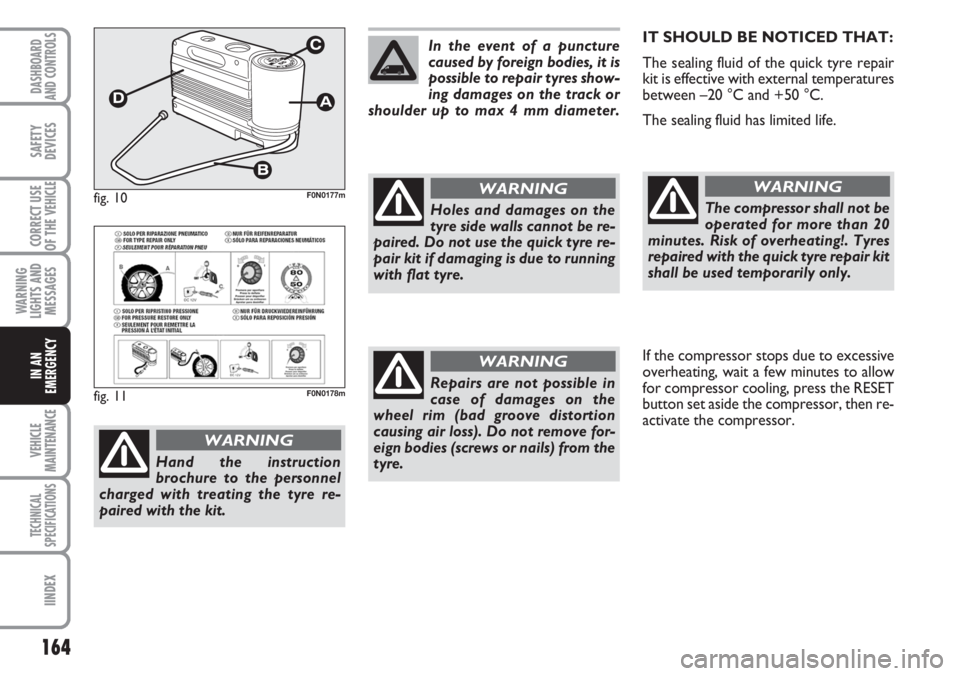
164
WARNING
LIGHTS AND
MESSAGES
VEHICLE
MAINTENANCE
TECHNICAL
SPECIFICATIONS
IINDEX
DASHBOARD
AND CONTROLS
SAFETY
DEVICES
CORRECT USE
OF THE
VEHICLE
IN AN
EMERGENCY
IT SHOULD BE NOTICED THAT:
The sealing fluid of the quick tyre repair
kit is effective with external temperatures
between –20 °C and +50 °C.
The sealing fluid has limited life.
The compressor shall not be
operated for more than 20
minutes. Risk of overheating!. Tyres
repaired with the quick tyre repair kit
shall be used temporarily only.
WARNING
In the event of a puncture
caused by foreign bodies, it is
possible to repair tyres show-
ing damages on the track or
shoulder up to max 4 mm diameter.
Holes and damages on the
tyre side walls cannot be re-
paired. Do not use the quick tyre re-
pair kit if damaging is due to running
with flat tyre.
WARNING
Repairs are not possible in
case of damages on the
wheel rim (bad groove distortion
causing air loss). Do not remove for-
eign bodies (screws or nails) from the
tyre.
WARNINGIf the compressor stops due to excessive
overheating, wait a few minutes to allow
for compressor cooling, press the RESET
button set aside the compressor, then re-
activate the compressor.
fig. 11F0N0178m
Hand the instruction
brochure to the personnel
charged with treating the tyre re-
paired with the kit.
WARNING
fig. 10F0N0177m
Page 166 of 282
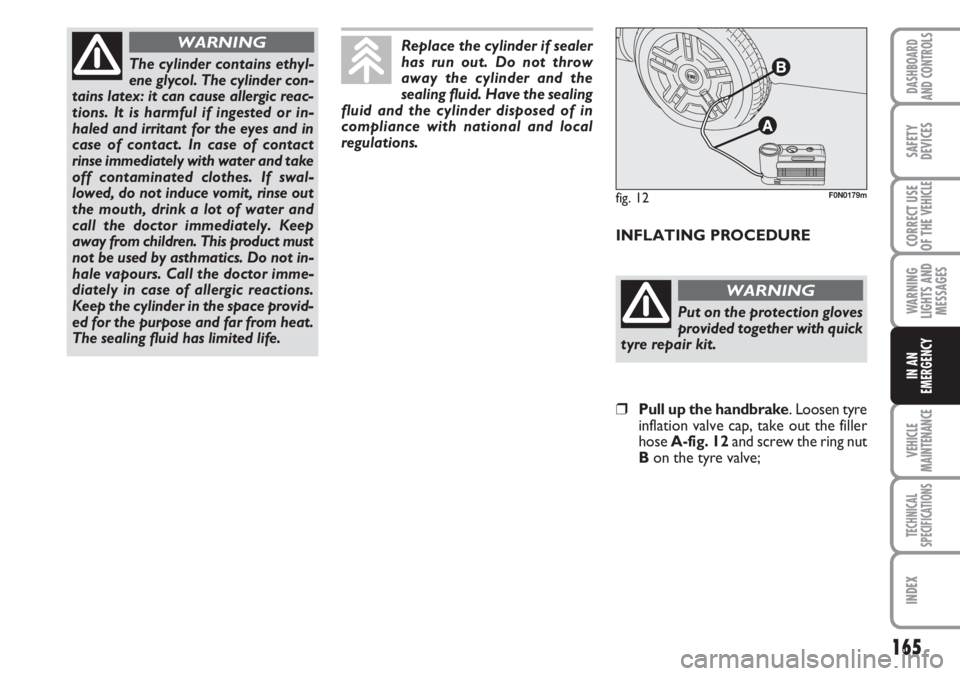
165
WARNING
LIGHTS AND
MESSAGES
VEHICLE
MAINTENANCE
TECHNICAL
SPECIFICATIONS
INDEX
DASHBOARD
AND CONTROLS
SAFETY
DEVICES
CORRECT USE
OF THE
VEHICLE
IN AN
EMERGENCY
The cylinder contains ethyl-
ene glycol. The cylinder con-
tains latex: it can cause allergic reac-
tions. It is harmful if ingested or in-
haled and irritant for the eyes and in
case of contact. In case of contact
rinse immediately with water and take
off contaminated clothes. If swal-
lowed, do not induce vomit, rinse out
the mouth, drink a lot of water and
call the doctor immediately. Keep
away from children. This product must
not be used by asthmatics. Do not in-
hale vapours. Call the doctor imme-
diately in case of allergic reactions.
Keep the cylinder in the space provid-
ed for the purpose and far from heat.
The sealing fluid has limited life.
WARNINGReplace the cylinder if sealer
has run out. Do not throw
away the cylinder and the
sealing fluid. Have the sealing
fluid and the cylinder disposed of in
compliance with national and local
regulations.
Put on the protection gloves
provided together with quick
tyre repair kit.
WARNING
❒Pull up the handbrake. Loosen tyre
inflation valve cap, take out the filler
hose A-fig. 12and screw the ring nut
Bon the tyre valve;
fig. 12F0N0179m
INFLATING PROCEDURE
Page 167 of 282
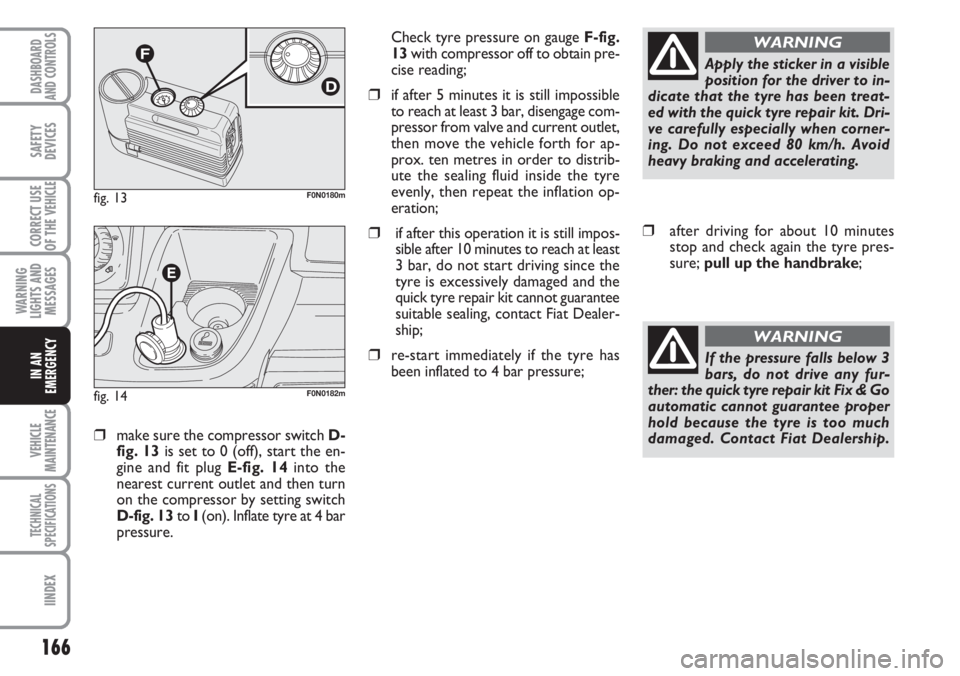
166
WARNING
LIGHTS AND
MESSAGES
VEHICLE
MAINTENANCE
TECHNICAL
SPECIFICATIONS
IINDEX
DASHBOARD
AND CONTROLS
SAFETY
DEVICES
CORRECT USE
OF THE
VEHICLE
IN AN
EMERGENCY
❒make sure the compressor switch D-
fig. 13is set to 0 (off), start the en-
gine and fit plug E-fig. 14into the
nearest current outlet and then turn
on the compressor by setting switch
D-fig. 13to I(on). Inflate tyre at 4 bar
pressure. Check tyre pressure on gauge F-fig.
13with compressor off to obtain pre-
cise reading;
❒if after 5 minutes it is still impossible
to reach at least 3 bar, disengage com-
pressor from valve and current outlet,
then move the vehicle forth for ap-
prox. ten metres in order to distrib-
ute the sealing fluid inside the tyre
evenly, then repeat the inflation op-
eration;
❒if after this operation it is still impos-
sible after 10 minutes to reach at least
3 bar, do not start driving since the
tyre is excessively damaged and the
quick tyre repair kit cannot guarantee
suitable sealing, contact Fiat Dealer-
ship;
❒re-start immediately if the tyre has
been inflated to 4 bar pressure;
fig. 13F0N0180m
fig. 14F0N0182m
Apply the sticker in a visible
position for the driver to in-
dicate that the tyre has been treat-
ed with the quick tyre repair kit. Dri-
ve carefully especially when corner-
ing. Do not exceed 80 km/h. Avoid
heavy braking and accelerating.
WARNING
❒after driving for about 10 minutes
stop and check again the tyre pres-
sure; pull up the handbrake;
If the pressure falls below 3
bars, do not drive any fur-
ther: the quick tyre repair kit Fix & Go
automatic cannot guarantee proper
hold because the tyre is too much
damaged. Contact Fiat Dealership.
WARNING
Page 168 of 282
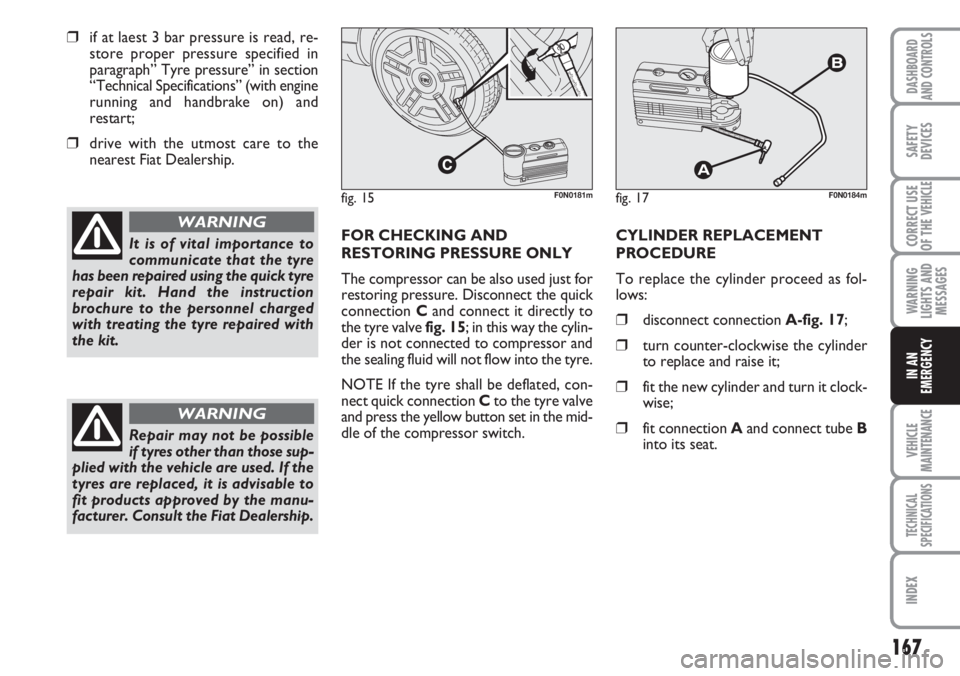
167
WARNING
LIGHTS AND
MESSAGES
VEHICLE
MAINTENANCE
TECHNICAL
SPECIFICATIONS
INDEX
DASHBOARD
AND CONTROLS
SAFETY
DEVICES
CORRECT USE
OF THE
VEHICLE
IN AN
EMERGENCY
❒if at laest 3 bar pressure is read, re-
store proper pressure specified in
paragraph” Tyre pressure” in section
“Technical Specifications” (with engine
running and handbrake on) and
restart;
❒drive with the utmost care to the
nearest Fiat Dealership.
FOR CHECKING AND
RESTORING PRESSURE ONLY
The compressor can be also used just for
restoring pressure. Disconnect the quick
connection Cand connect it directly to
the tyre valve fig. 15; in this way the cylin-
der is not connected to compressor and
the sealing fluid will not flow into the tyre.
NOTE If the tyre shall be deflated, con-
nect quick connection Cto the tyre valve
and press the yellow button set in the mid-
dle of the compressor switch.CYLINDER REPLACEMENT
PROCEDURE
To replace the cylinder proceed as fol-
lows:
❒disconnect connection A-fig. 17;
❒turn counter-clockwise the cylinder
to replace and raise it;
❒fit the new cylinder and turn it clock-
wise;
❒fit connection Aand connect tube B
into its seat.
It is of vital importance to
communicate that the tyre
has been repaired using the quick tyre
repair kit. Hand the instruction
brochure to the personnel charged
with treating the tyre repaired with
the kit.
WARNING
fig. 17F0N0184mfig. 15F0N0181m
Repair may not be possible
if tyres other than those sup-
plied with the vehicle are used. If the
tyres are replaced, it is advisable to
fit products approved by the manu-
facturer. Consult the Fiat Dealership.
WARNING
Page 169 of 282
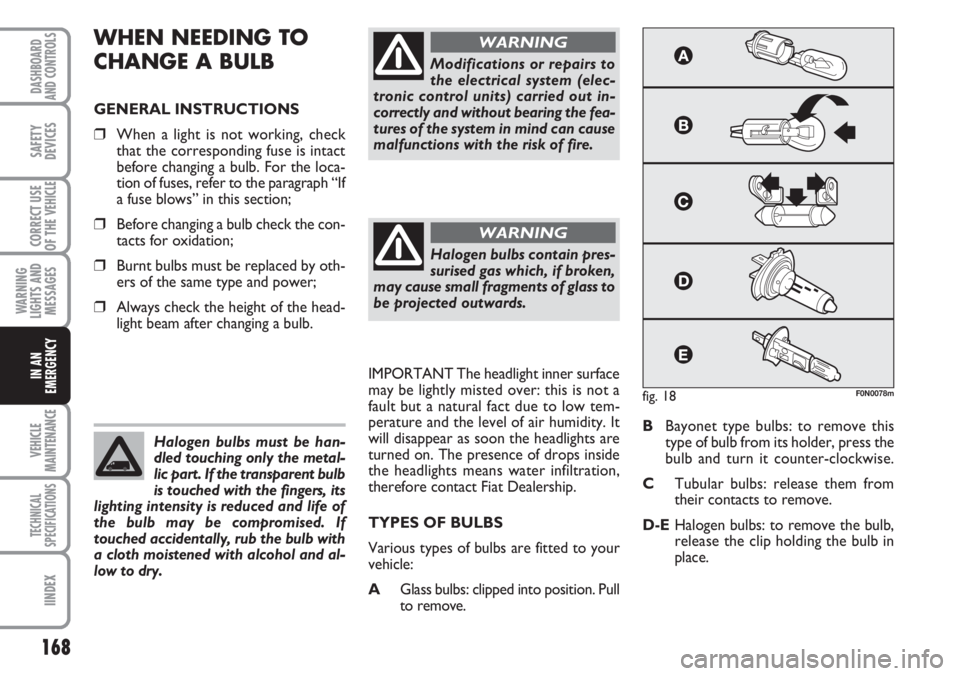
168
WARNING
LIGHTS AND
MESSAGES
VEHICLE
MAINTENANCE
TECHNICAL
SPECIFICATIONS
IINDEX
DASHBOARD
AND CONTROLS
SAFETY
DEVICES
CORRECT USE
OF THE
VEHICLE
IN AN
EMERGENCY
WHEN NEEDING TO
CHANGE A BULB
GENERAL INSTRUCTIONS
❒When a light is not working, check
that the corresponding fuse is intact
before changing a bulb. For the loca-
tion of fuses, refer to the paragraph “If
a fuse blows” in this section;
❒Before changing a bulb check the con-
tacts for oxidation;
❒Burnt bulbs must be replaced by oth-
ers of the same type and power;
❒Always check the height of the head-
light beam after changing a bulb.
IMPORTANT The headlight inner surface
may be lightly misted over: this is not a
fault but a natural fact due to low tem-
perature and the level of air humidity. It
will disappear as soon the headlights are
turned on. The presence of drops inside
the headlights means water infiltration,
therefore contact Fiat Dealership.
TYPES OF BULBS
Various types of bulbs are fitted to your
vehicle:
AGlass bulbs: clipped into position. Pull
to remove.BBayonet type bulbs: to remove this
type of bulb from its holder, press the
bulb and turn it counter-clockwise.
CTubular bulbs: release them from
their contacts to remove.
D-EHalogen bulbs: to remove the bulb,
release the clip holding the bulb in
place. Halogen bulbs must be han-
dled touching only the metal-
lic part. If the transparent bulb
is touched with the fingers, its
lighting intensity is reduced and life of
the bulb may be compromised. If
touched accidentally, rub the bulb with
a cloth moistened with alcohol and al-
low to dry.
Modifications or repairs to
the electrical system (elec-
tronic control units) carried out in-
correctly and without bearing the fea-
tures of the system in mind can cause
malfunctions with the risk of fire.
WARNING
Halogen bulbs contain pres-
surised gas which, if broken,
may cause small fragments of glass to
be projected outwards.
WARNING
fig. 18F0N0078m
Page 170 of 282
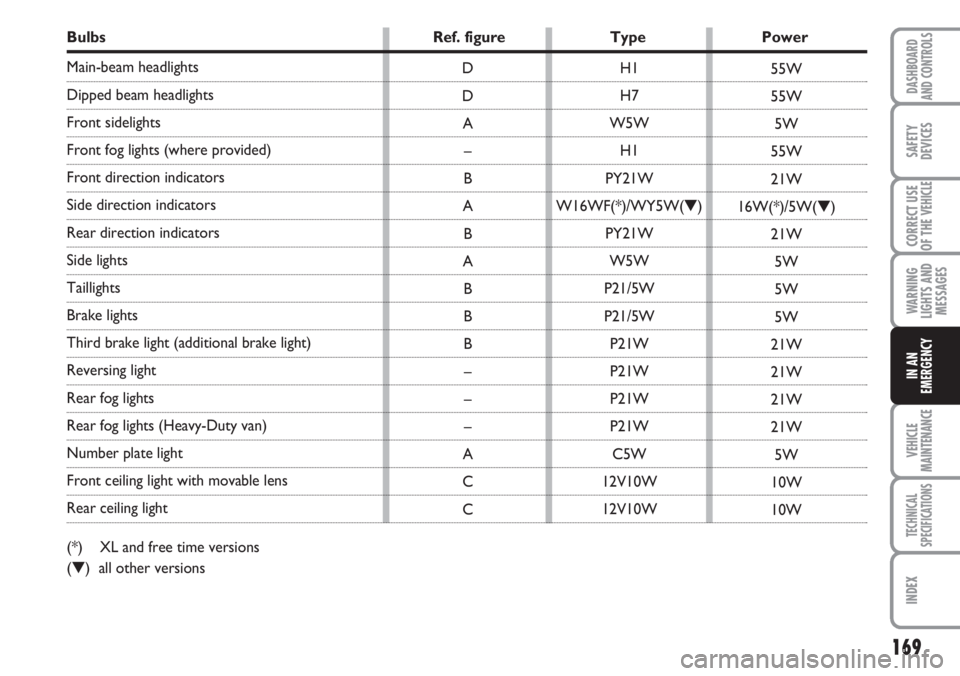
169
WARNING
LIGHTS AND
MESSAGES
VEHICLE
MAINTENANCE
TECHNICAL
SPECIFICATIONS
INDEX
DASHBOARD
AND CONTROLS
SAFETY
DEVICES
CORRECT USE
OF THE
VEHICLE
IN AN
EMERGENCY
Bulbs Ref. figure Type Power
Main-beam headlights
Dipped beam headlights
Front sidelights
Front fog lights (where provided)
Front direction indicators
Side direction indicators
Rear direction indicators
Side lights
Taillights
Brake lights
Third brake light (additional brake light)
Reversing light
Rear fog lights
Rear fog lights (Heavy-Duty van)
Number plate light
Front ceiling light with movable lens
Rear ceiling light
(*) XL and free time versions
(▼) all other versionsH1
H7
W5W
H1
PY21W
W16WF(*)/WY5W(▼)
PY21W
W5W
P21/5W
P21/5W
P21W
P21W
P21W
P21W
C5W
12V10W
12V10W D
D
A
–
B
A
B
A
B
B
B
–
–
–
A
C
C55W
55W
5W
55W
21W
16W(*)/5W(▼)
21W
5W
5W
5W
21W
21W
21W
21W
5W
10W
10W
Page 171 of 282
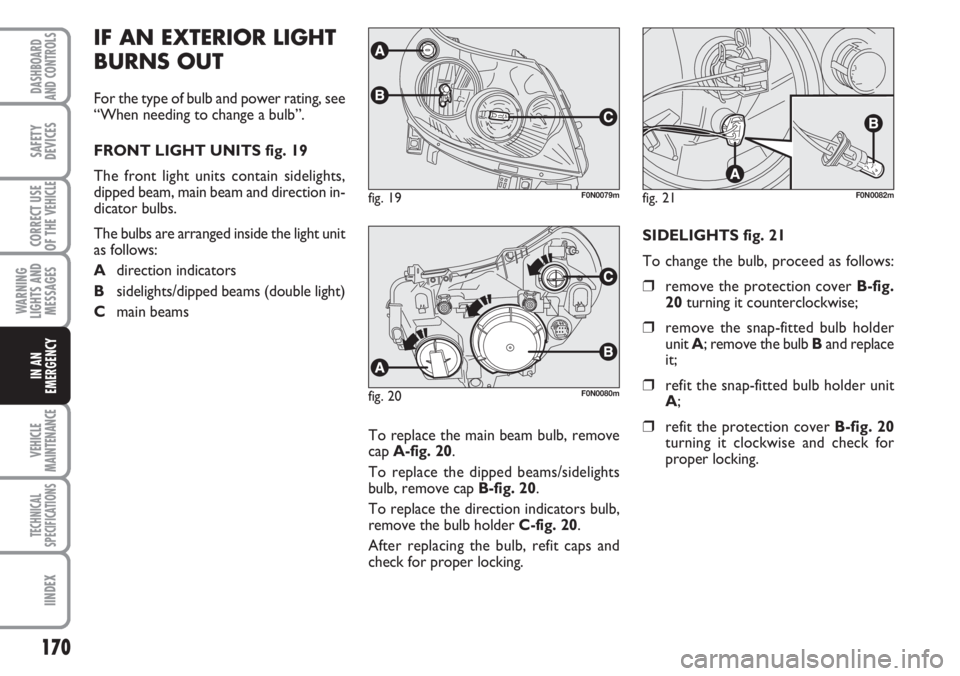
170
WARNING
LIGHTS AND
MESSAGES
VEHICLE
MAINTENANCE
TECHNICAL
SPECIFICATIONS
IINDEX
DASHBOARD
AND CONTROLS
SAFETY
DEVICES
CORRECT USE
OF THE
VEHICLE
IN AN
EMERGENCY
IF AN EXTERIOR LIGHT
BURNS OUT
For the type of bulb and power rating, see
“When needing to change a bulb”.
FRONT LIGHT UNITS fig. 19
The front light units contain sidelights,
dipped beam, main beam and direction in-
dicator bulbs.
The bulbs are arranged inside the light unit
as follows:
Adirection indicators
Bsidelights/dipped beams (double light)
Cmain beams
To replace the main beam bulb, remove
cap A-fig. 20.
To replace the dipped beams/sidelights
bulb, remove cap B-fig. 20.
To replace the direction indicators bulb,
remove the bulb holder C-fig. 20.
After replacing the bulb, refit caps and
check for proper locking.SIDELIGHTS fig. 21
To change the bulb, proceed as follows:
❒remove the protection cover B-fig.
20turning it counterclockwise;
❒remove the snap-fitted bulb holder
unit A; remove the bulb Band replace
it;
❒refit the snap-fitted bulb holder unit
A;
❒refit the protection cover B-fig. 20
turning it clockwise and check for
proper locking.
fig. 19F0N0079mfig. 21F0N0082m
fig. 20F0N0080m
Page 172 of 282
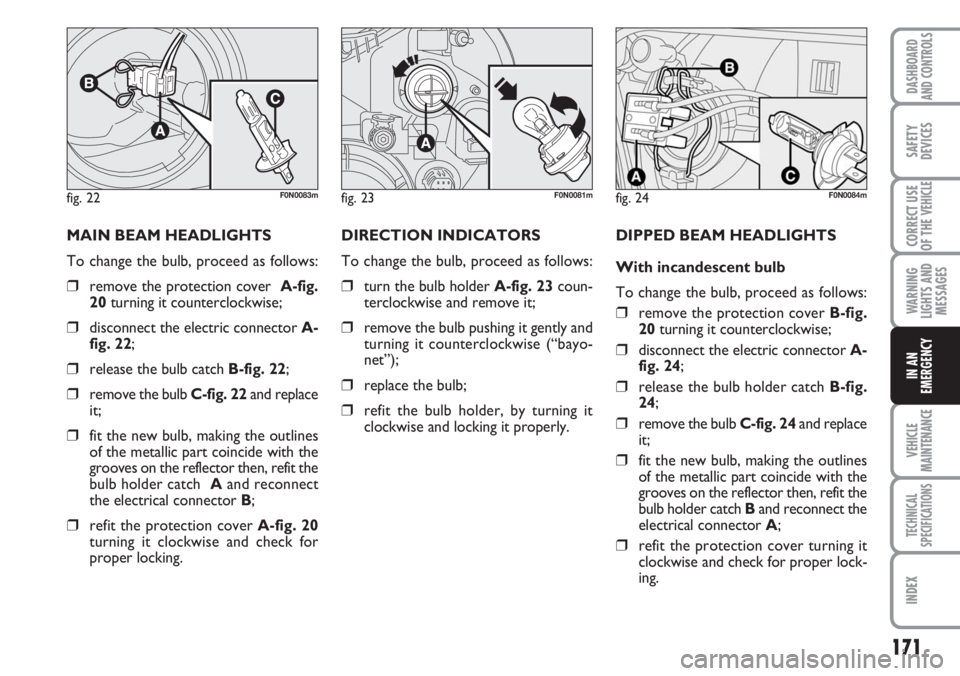
171
WARNING
LIGHTS AND
MESSAGES
VEHICLE
MAINTENANCE
TECHNICAL
SPECIFICATIONS
INDEX
DASHBOARD
AND CONTROLS
SAFETY
DEVICES
CORRECT USE
OF THE
VEHICLE
IN AN
EMERGENCY
MAIN BEAM HEADLIGHTS
To change the bulb, proceed as follows:
❒remove the protection cover A-fig.
20 turning it counterclockwise;
❒disconnect the electric connector A-
fig. 22;
❒release the bulb catch B-fig. 22;
❒remove the bulb C-fig. 22 and replace
it;
❒fit the new bulb, making the outlines
of the metallic part coincide with the
grooves on the reflector then, refit the
bulb holder catch Aand reconnect
the electrical connector B;
❒refit the protection cover A-fig. 20
turning it clockwise and check for
proper locking.DIRECTION INDICATORS
To change the bulb, proceed as follows:
❒turn the bulb holder A-fig. 23coun-
terclockwise and remove it;
❒remove the bulb pushing it gently and
turning it counterclockwise (“bayo-
net”);
❒replace the bulb;
❒refit the bulb holder, by turning it
clockwise and locking it properly.DIPPED BEAM HEADLIGHTS
With incandescent bulb
To change the bulb, proceed as follows:
❒remove the protection cover B-fig.
20turning it counterclockwise;
❒disconnect the electric connector A-
fig. 24;
❒release the bulb holder catch B-fig.
24;
❒remove the bulb C-fig. 24and replace
it;
❒fit the new bulb, making the outlines
of the metallic part coincide with the
grooves on the reflector then, refit the
bulb holder catch Band reconnect the
electrical connector A;
❒refit the protection cover turning it
clockwise and check for proper lock-
ing.
fig. 22F0N0083mfig. 23F0N0081mfig. 24F0N0084m
Page 173 of 282
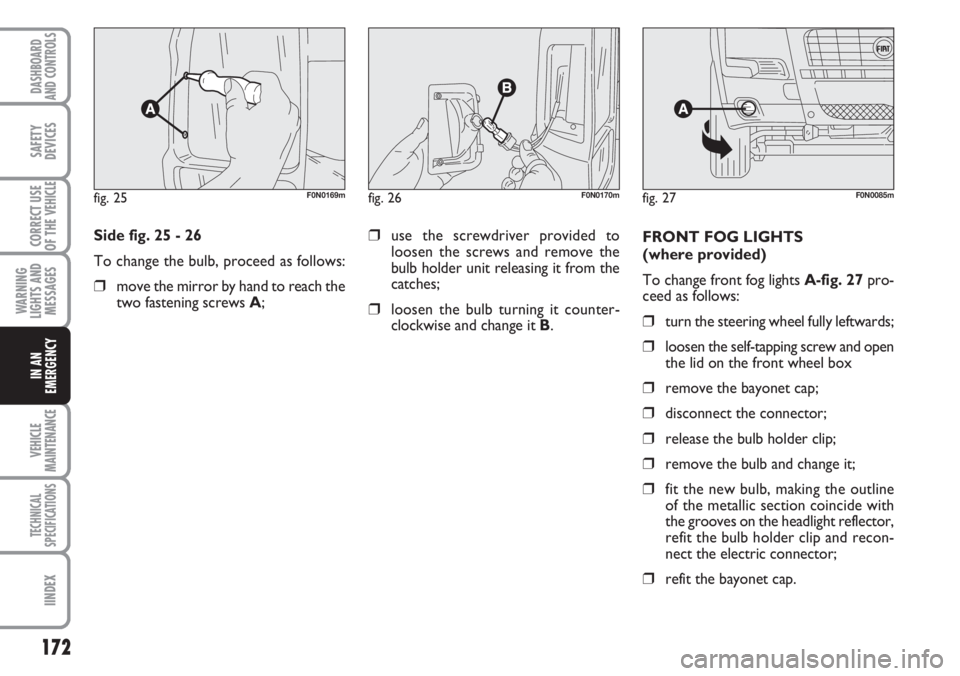
172
WARNING
LIGHTS AND
MESSAGES
VEHICLE
MAINTENANCE
TECHNICAL
SPECIFICATIONS
IINDEX
DASHBOARD
AND CONTROLS
SAFETY
DEVICES
CORRECT USE
OF THE
VEHICLE
IN AN
EMERGENCY
Side fig. 25 - 26
To change the bulb, proceed as follows:
❒move the mirror by hand to reach the
two fastening screws A;FRONT FOG LIGHTS
(where provided)
To change front fog lights A-fig. 27pro-
ceed as follows:
❒turn the steering wheel fully leftwards;
❒loosen the self-tapping screw and open
the lid on the front wheel box
❒remove the bayonet cap;
❒disconnect the connector;
❒release the bulb holder clip;
❒remove the bulb and change it;
❒fit the new bulb, making the outline
of the metallic section coincide with
the grooves on the headlight reflector,
refit the bulb holder clip and recon-
nect the electric connector;
❒refit the bayonet cap.
fig. 25F0N0169mfig. 27F0N0085mfig. 26F0N0170m
❒use the screwdriver provided to
loosen the screws and remove the
bulb holder unit releasing it from the
catches;
❒loosen the bulb turning it counter-
clockwise and change it B.
Page 174 of 282
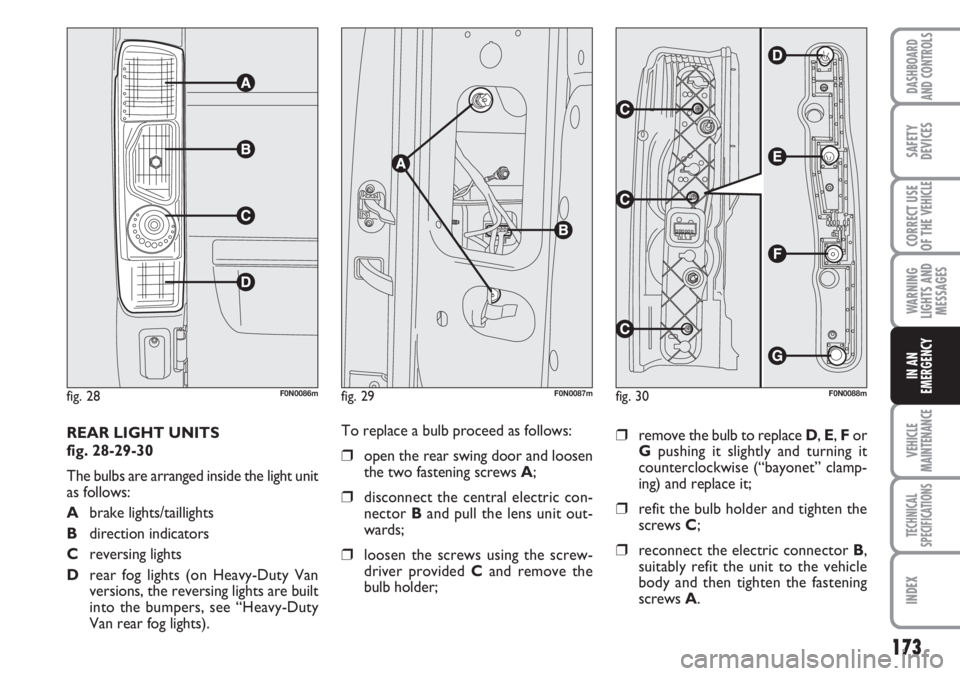
173
WARNING
LIGHTS AND
MESSAGES
VEHICLE
MAINTENANCE
TECHNICAL
SPECIFICATIONS
INDEX
DASHBOARD
AND CONTROLS
SAFETY
DEVICES
CORRECT USE
OF THE
VEHICLE
IN AN
EMERGENCY
REAR LIGHT UNITS
fig. 28-29-30
The bulbs are arranged inside the light unit
as follows:
Abrake lights/taillights
Bdirection indicators
Creversing lights
Drear fog lights (on Heavy-Duty Van
versions, the reversing lights are built
into the bumpers, see “Heavy-Duty
Van rear fog lights).
fig. 28F0N0086m
To replace a bulb proceed as follows:
❒open the rear swing door and loosen
the two fastening screws A;
❒disconnect the central electric con-
nector B and pull the lens unit out-
wards;
❒loosen the screws using the screw-
driver provided Cand remove the
bulb holder;
❒remove the bulb to replace D, E, For
Gpushing it slightly and turning it
counterclockwise (“bayonet” clamp-
ing) and replace it;
❒refit the bulb holder and tighten the
screws C;
❒reconnect the electric connector B,
suitably refit the unit to the vehicle
body and then tighten the fastening
screws A.
fig. 30F0N0088mfig. 29F0N0087m